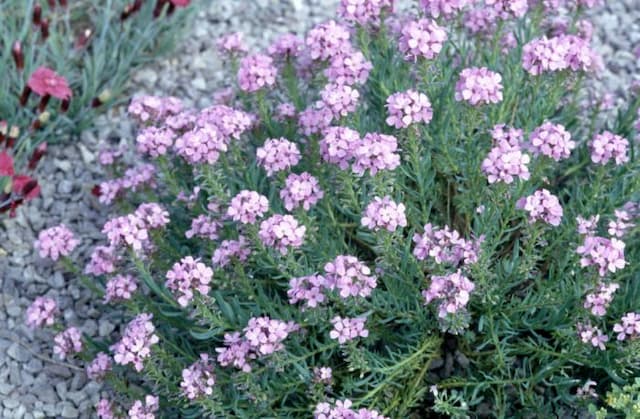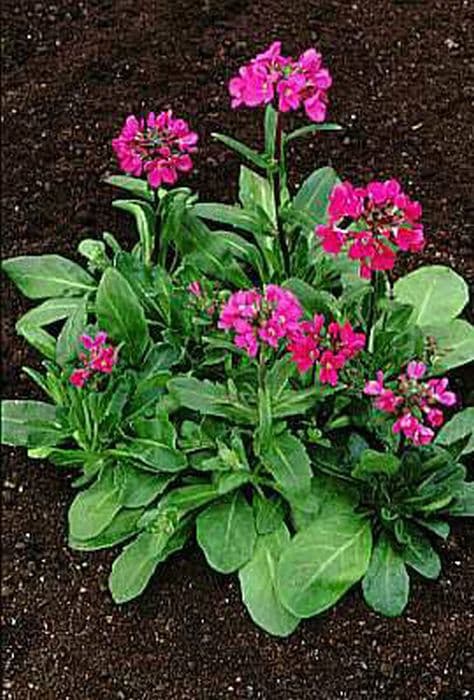Doubleflowered Rockcress Arabis alpina subsp. caucasica 'Flore Pleno' (d)

ABOUT
The plant commonly known as double-flowered rock cress displays a mound-forming habit with dense tufts of small, spoon-shaped leaves. These leaves are typically deep green in color, which creates a lush, ground-hugging foliage. The true showstoppers are its flowers, which are double, giving them a frilly, pom-pom like appearance. Instead of the single four-petaled flowers found in its relatives, the double-flowered rock cress boasts numerous layers of petals, resulting in blooms that are both fuller and more ornamental. These flowers tend to be bright white, which offers a striking contrast against the green backdrop of the foliage. This plant often blooms in the spring, creating a blanket of white that attracts various pollinators. Overall, its appearance is one that can add texture and visual interest to rock gardens and borders due to its plush flower heads and spreading foliage.
About this plant
 Names
NamesFamily
Brassicaceae.
Synonyms
Double Caucasian Rockcress, Double Alpine Rockcress, Garden Arabis, Flore Pleno.
Common names
Arabis caucasica 'Flore Pleno', Arabis albida 'Flore Pleno'.
 Toxicity
ToxicityTo humans
The common name for Arabis alpina subsp. caucasica 'Flore Pleno' is Double Rockcress. Double Rockcress is not commonly known for its toxicity to humans. However, as with any plant, it is recommended to exercise caution and avoid ingestion of plants that are not widely recognized as edible or medicinal to prevent unexpected allergic reactions or gastrointestinal discomfort.
To pets
Double Rockcress is not widely recognized as a toxic plant to pets. However, pets, like humans, may experience adverse effects if they consume plants that are not part of their typical diet, such as vomiting or diarrhea. It is always best to keep an eye on pets and prevent them from ingesting ornamental plants. If you suspect your pet has ingested a potentially harmful plant, you should contact a veterinarian.
 Characteristics
CharacteristicsLife cycle
Perennials
Foliage type
Evergreen
Color of leaves
Green
Flower color
White
Height
0.5 feet (15 cm)
Spread
1 foot (30 cm)
Plant type
Herb
Hardiness zones
4
Native area
Europe
Benefits
 General Benefits
General Benefits- Ornamental value: The Arabis alpina subsp. caucasica 'Flore Pleno', commonly known as Double-flowered Alpine Rock Cress, has aesthetic appeal due to its dense clusters of frilly white double flowers.
- Extended blooming period: This variety of Alpine Rock Cress typically offers a longer flowering season, enhancing garden interest throughout spring and into early summer.
- Low maintenance: Double-flowered Alpine Rock Cress is easy to grow and requires minimal upkeep, making it ideal for gardeners seeking low-maintenance options.
- Drought tolerance: The plant is relatively drought-resistant once established, making it suitable for dry or xeriscaped gardens.
- Pollinator-friendly: The flowers attract beneficial insects such as bees and butterflies, contributing to local biodiversity.
- Ground cover: Alpine Rock Cress forms a mat-like growth habit, which can help prevent erosion and suppress weed growth.
- Cold resistance: As a subalpine species, it is tolerant of cold temperatures and can survive in harsher climates.
- Rapid growth: The plant can quickly cover ground, providing a swift green and floral display in suitable growing conditions.
- Rock garden suitability: Its natural habitat is rocky slopes, which makes it perfect for rock gardens or alpine collections.
- Edging plant: Due to its compact and spreading nature, it can be used effectively as a border or edging plant in gardens.
 Medical Properties
Medical PropertiesThis plant is not used for medical purposes.
 Air-purifying Qualities
Air-purifying QualitiesThis plant is not specifically known for air purifying qualities.
 Other Uses
Other Uses- Photography backdrop: Garden enthusiasts and photographers sometimes use the dense, white-flowered clusters of Arabis alpina as a backdrop for close-up photography of insects and other small wildlife.
- Education: Arabis alpina can be used in educational settings to demonstrate alpine plant adaptation and survival strategies in harsh, mountainous environments.
- Aromatherapy: While not a primary use, some people enjoy the subtle scent of Arabis alpina and may use it in their homes to contribute to a calming atmosphere.
- Artistic inspiration: The intricate blooms and growth habit of Arabis alpina provide a unique source of inspiration for artists, particularly those who specialize in botanical illustration.
- Culinary garnish: The flowers can occasionally be used as an edible decoration for salads and desserts, though they are not widely recognized for their taste.
- Rock garden architecture: Arabis alpina's natural growth patterns can inspire the layout and design of rock gardens, demonstrating how plants naturally navigate rocky terrains.
- Seasonal celebrations: In some cultures, the springtime blooming of Arabis alpina might be used to symbolize renewal and incorporated into seasonal festivals or decorations.
- Dye source: Occasionally, the plant’s parts can be experimented with as a source of natural dyes for textiles, though it is not a well-documented use.
- Biological studies: Arabis alpina is sometimes used by botanists and geneticists studying gene expression and plant responses to cold climates.
- Landscape modeling: Miniature landscapes, such as those for model trains or dioramas, could utilize Arabis alpina to replicate alpine environments on a small scale.
Interesting Facts
 Feng Shui
Feng ShuiThe Rock Cress is not used in Feng Shui practice.
 Zodiac Sign Compitability
Zodiac Sign CompitabilityThe Rock Cress is not used in astrology practice.
 Plant Symbolism
Plant Symbolism- Purity: The white flowers of Arabis caucasica, commonly referred to as rock cress, often symbolize purity due to their clean, crisp color.
- Survival and Resilience: As a plant that thrives in alpine conditions, rock cress represents the ability to survive and flourish in harsh and challenging environments.
- Innocence: Again, the white blossoms are associated with innocence, reflecting an unspoiled and untouched aspect of nature.
- Vitality: Rock cress's early bloom, often one of the first signs of spring, can symbolize new life and renewed vitality.
 Water
WaterThe most common name of Arabis alpina subsp. caucasica 'Flore Pleno' is the 'Double Alpine Rockcress.' To properly water this plant, it should be given a thorough soaking whenever the top inch of soil feels dry to the touch. Generally, this may mean watering once every week, but frequency can be less during cooler months and more during hot spells. Slowly pour water around the base of the plant until it begins to run from the bottom of the pot or is absorbed into the surrounding ground, which could range from 16 to 32 ounces for potted plants, or 1 to 2 gallons for those in the ground, depending on plant size and environmental conditions.
 Light
Light'Double Alpine Rockcress' thrives best in full sun to partial shade conditions. Ideally, the plant should be placed in a spot where it can receive at least four to six hours of sunlight daily. While it tolerates light shade, flowering is often more abundant when the plant is exposed to ample sunlight.
 Temperature
TemperatureFor the 'Double Alpine Rockcress,' the ideal temperature range is between 60 to 75 degrees Fahrenheit. It can survive cooler temperatures down to about 20 degrees Fahrenheit and can handle some heat, but prolonged exposure to temperatures above 80 degrees Fahrenheit may stress the plant. This perennial is cold-hardy and can survive winters in climates where temperatures do not frequently drop below freezing.
 Pruning
PruningThe 'Double Alpine Rockcress' should be pruned to remove spent flowers and encourage bushier growth. Deadheading, or snipping off the faded blooms, can be done throughout the flowering season to stimulate new buds. Additionally, a more thorough pruning can be carried out immediately after flowering to shape the plant and remove any leggy or dead stems. This is usually done annually, after the main bloom cycle in spring or early summer.
 Cleaning
CleaningAs needed
 Soil
SoilMountain rock cress requires well-draining soil with a mixture of loam, sand, and garden compost. It thrives in a slightly alkaline to neutral pH range of 7.0 to 7.5. A top dressing of gravel can aid in drainage and mimic its native alpine conditions.
 Repotting
RepottingMountain rock cress does not require frequent repotting and can be done every 2 to 3 years, or as necessary if the plant outgrows its current container or the soil becomes depleted.
 Humidity & Misting
Humidity & MistingMountain rock cress is adapted to outdoor conditions with typical air humidity and does not require high humidity levels. It thrives in average outdoor humidity ranges without needing special attention.
 Suitable locations
Suitable locationsIndoor
Provide bright light and cool temps.
Outdoor
Plant in full sun, well-drained soil.
Hardiness zone
4-8 USDA
 Life cycle
Life cycleThe Arabis alpina subsp. caucasica 'Flore Pleno', commonly known as Double Caucasian Rockcress, begins its life as a seed that germinates in late winter or early spring, depending on the climate. Upon germination, the plant develops a small rosette of basal leaves close to the ground, which allows it to survive in its alpine or rock garden habitats. As it matures, it produces stems with more leaves and eventually buds that will develop into its characteristic clusters of double, white flowers in spring to early summer. After flowering, the plant sets seeds which are then dispersed by wind or wildlife, enabling the propagation of new plants. During the summer, the foliage may die back, particularly in hotter climates, but the plant’s root system remains alive, and the plant enters a period of dormancy. In the following spring, the cycle begins anew, with the plant emerging from dormancy to grow, flower, and set seed once again.
 Propogation
PropogationPropogation time
Spring to Summer
The most popular method of propagating Arabis alpina subsp. caucasica 'Flore Pleno', commonly known as the double-flowered rockcress, is through seed sowing. Seeds can be started indoors about 6 to 8 weeks before the last expected frost. Fill a seed tray with potting mix, then scatter the seeds on the surface and lightly cover with soil. Keep the soil moist but not waterlogged, and maintain a temperature between 65 to 70 degrees Fahrenheit (18 to 21 degrees Celsius). Seedlings should emerge in 14 to 21 days, and once they are large enough to handle and after all risk of frost has passed, they can be transplanted outdoors at a spacing of about 12 inches (30 centimeters) apart.





![Aubrieta [Axcent Burgundy]](/_next/image?url=https%3A%2F%2Fplants-admin.emdemapps.com%2Fimages%2Fplants%2F%2Fimages%2F604b5b7b548d8.png&w=640&q=75)



